Huge amounts of hazardous materials pass through Midwest every day. Are residents safe?
The wake-up call came Feb. 3 in eastern Ohio.
A Norfolk Southern freight train rumbling through the village of East Palestine jumped the track. Damaged tank cars spewed toxic chemicals into the air and water. A massive fire lit up the sky. More chemicals were burned days later. Polluted runoff flowed into waterways.
Nearly six months later, the cleanup is still underway. Damage could run into hundreds of millions of dollars, while long-term health and environmental ramifications remain unknown.
More than 1 million hazmat shipments pass through small towns, major cities and vast expanses of rural land across the United States every day. “More than 99% arrive without incident,” said Tim Butters, a transportation safety consultant who previously worked for the federal Pipeline and Hazardous Materials Safety Administration.
East Palestine, statistically speaking, is an outlier. But it's also a warning.
“These train derailments, especially ones carrying these terrible chemicals, should be ‘never events,’” said Misti Allison, a 35-year-old wife and mother who lives about a mile from the East Palestine crash site.
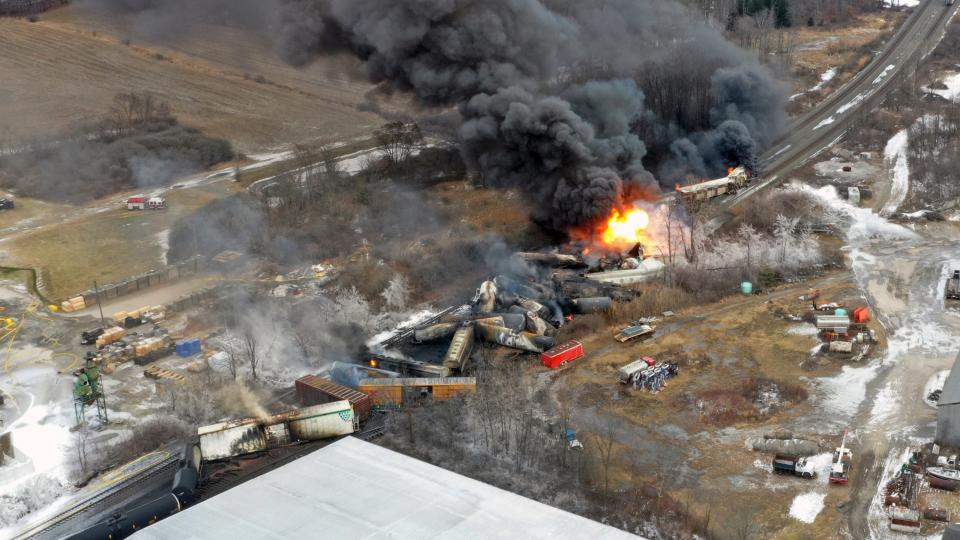
Allison and her family were among those evacuated. In the aftermath, she struggles with “the fear of the unknown.” The nagging concern extends beyond one family or one small town to a universal question that resonates across America: Where and when will the next big accident happen?
“Shame on people that are saying it's safe,” Allison said. “It's not safe enough.”
The accident in East Palestine may be an extreme example, but a USA TODAY analysis of federal data found it far from an isolated incident. The review of records on thousands of hazmat accidents in Illinois, Indiana, Kentucky, Ohio and Michigan revealed:
The five Midwest states accounted for more than 20% of all hazmat incidents since 2013.
The annual number of incidents grew from about 3,400 in 2013 to 5,300 last year — a total of 46,049 in the past decade.
At least 638 of those accidents were deemed “serious,” indicating deaths or injuries, mass evacuations, or large hazmat releases.
Trucks accounted for 93% of the hazmat incidents, and the raw numbers are growing.
Since 2013, Norfolk Southern trains accounted for about one-third of the region's Top 20 accidents based on monetary damages.
Hazmat transportation accidents killed six — all truck drivers — in the last decade, with nearly 400 others injured.
Note: Click on a map to make a magnifying glass icon appear to zoom in. If the graph above isn't loading click here.
The disaster in East Palestine exposed gaps in safety practices and emergency response procedures, as well as other challenges presented by the enormous volume of dangerous materials constantly on the move. It also prompted calls for better regulation of their shipping, a heightened focus on preventing accidents, and more help preparing local hazmat responders.
Change will not be easy. Economic demands and industry pushback have stalled or weakened many past efforts to enhance safety regulations.
Without reforms, local emergency responders are the last line of defense. Depending on where an accident happens, they could be professional hazmat teams or volunteer firefighters. All have some level of training, but it can vary from several hours of general instruction to years of in-depth experience.
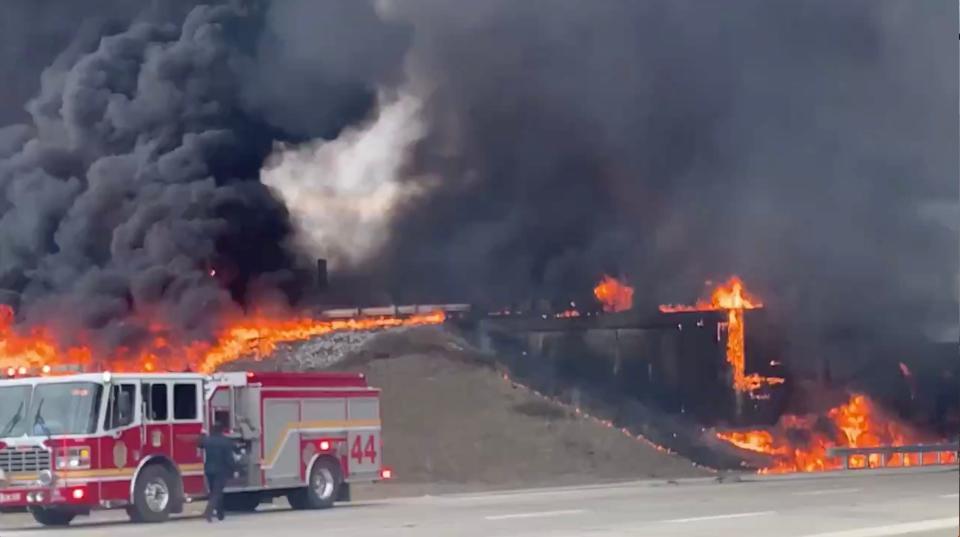
The final outcome — the factor that may determine the difference between life and death, environmental disaster or crisis averted — often comes down to the unpredictable timing and location of hazmat accidents. While first responders can prepare for accidents, they can’t prevent them. Instead, they’re left to chase after the next potential disaster like a high-stakes game of Whac-A-Mole.
Chemical industry deemed ‘critical infrastructure’
Most Americans are oblivious to the hazardous materials moving all around them and how prevalent they are in everyday items. They don’t know what’s in the train passing in front of them at a crossing or the tanker rolling down the highway at 70 mph in the next lane.
Allison, the young East Palestine wife and mother, said she rarely considered the cargo on trains rolling through the village where her family has deep roots. That all changed when her phone pinged as she tucked her two children into bed on a winter night. The text message was from a relative: A train had derailed about a mile from the family's home.

Allison and her husband stepped outside. A huge plume of flames illuminated the night sky. They could hear the emergency responders and feel the ground shake.
“A lot of people imagined passing freight trains as just a part of small-town life, a kind of background noise,” Allison said. “But what happened in East Palestine really shattered that misconception for many of us.”
There's a reason so many hazmats continuously crisscross the U.S. on trains, trucks, barges and airplanes: Many of them are central to everyday life ― key components in everything from safe drinking water and medicine to plastics and agriculture products.
They are so important that the federal government has deemed the chemical industry to be “critical infrastructure” along with key systems for communications, energy, banking and health care.
“That gives some perspective to this,” said Scott Jensen of the American Chemistry Council, a trade association for chemical companies. “The federal government has recognized the criticality of these materials.”
Paint products are the most frequently spilled hazmat in transportation accidents, and they seldom result in serious damages. Other products frequently involved in accidents are far more volatile and dangerous. Gasoline and diesel fuel for vehicles and generators. Propylene used for plastic and packaging. Chlorine for disinfectants and pharmaceuticals. Sulfuric acid used in paper production and batteries. Anhydrous ammonia for fertilizer and refrigerants.
In East Palestine, the threat was magnified by a mixture of chemicals, including vinyl chloride, a carcinogen used in the production of PVC pipes, wire coating and plastic kitchenware.
Hazmat accidents on the rise, driven by trucks
There were more than 25,000 hazmat transportation accidents last year in the U.S., according to federal records. That number has increased steadily since 2013, when there were about 16,000.
Three Midwestern states at the crossroads of America are in the Top 10 for total accidents over the last decade: Illinois (3), Ohio (4) and Indiana (9). Kentucky and Michigan came in at 16 and 17, respectively. The total includes accidents during loading and unloading, and while shipments are in transit. Accidents that happen on the move, such as derailments and crashes, are most likely to be "serious" and account for over 90% of total damages — which topped $237 million in the region in the last decade.
Most of the growth in accident numbers came in the trucking sector, which transports more than 90% of the shipments, according to PHMSA. While the East Palestine accidents attracted wide attention, rail accidents have dipped slightly in recent years. Water and air incidents, which represent only a fraction of the total, remained fairly constant.
Across Illinois, Indiana, Kentucky, Michigan and Ohio last year, officials reported more than 5,300 hazmat accidents — an average of 14 a day. Forty-five were classified as serious.
In one of those serious accidents, a tractor trailer carrying oxone, which is used to disinfect pools, caught on fire while traveling through the small Northern Kentucky town of Sparta in May 2022. The fire damaged a post office building and forced nearby residents to evacuate. The chemical spilled onto the nearby soil and into the creek.
In another accident in August, a tractor trailer carrying diesel fuel was driving through Fife Lake, Michigan, when a car crossed over the center lane and struck it head-on. The crash released fuel from the truck’s load and shut down the highway. The driver of the car died.
A third serious accident happened in December at Raceland in Eastern Kentucky, when a CSX Transportation train leaked xylenol, which is used to produce disinfectants and fungicides.
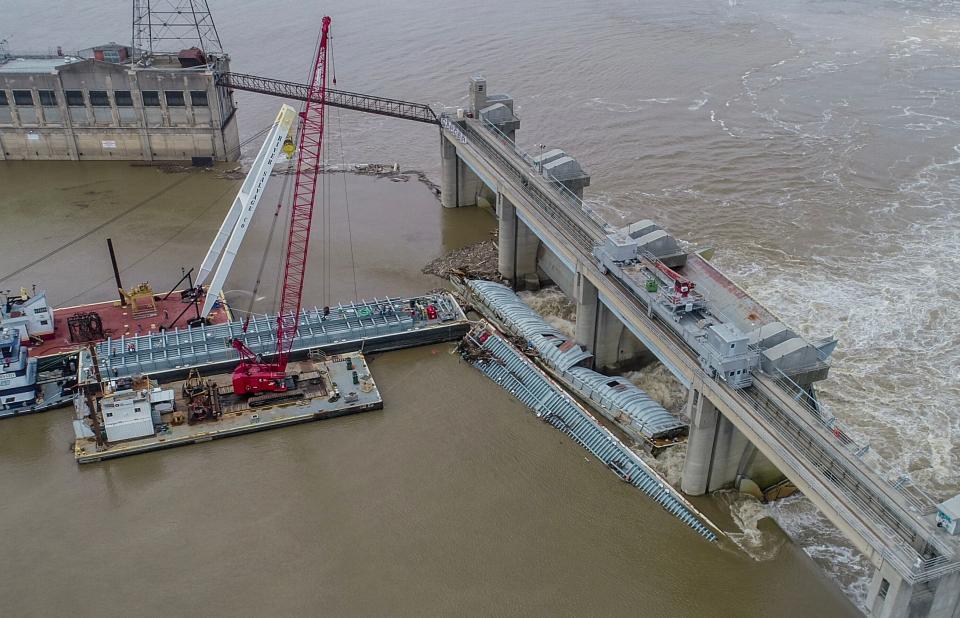
Those examples point to a scary reality. There's a risk of a hazmat accident anywhere with roads, rivers, rail lines or industrial plants.
“It just really takes one rail tank car — not even a whole train,” explained Allison, who's been spurred to advocacy by her family’s experience. “One car can be enough to destroy an entire city.”
The majority of hazmat accidents in the five-state region — nearly 90% — occurred in urban and suburban counties with industrial and manufacturing hubs where large quantities of hazardous materials come and go daily. That includes places such as Indianapolis, Grand Rapids, Louisville, Cincinnati and Hodgkins, Illinois, an industrial suburb of Chicago that has recorded the region’s most hazmat accidents in the past decade.
But accident data shows rural communities like East Palestine and Sparta, Kentucky, face an outsized risk when it comes to serious damages. The challenge outside metropolitan areas comes from the thousands of miles of highways and rail lines that connect them.
When zooming in on in-transit accidents deemed “serious,” the portion occurring in rural counties jumps to about 37%. More troubling, in many of those areas the first responders are volunteer firefighters who may not have the equipment, training and experience to quickly assess and respond to a potentially catastrophic event.
“The cities are much better prepared,” said Ohio Fire Marshal Keith Reardon. It is a statement echoed by his counterparts in other states — and it's not a dig.
Anne Junod, senior research associate at the Urban Institute, said the risk for low-income and rural communities may be even greater than county-level data suggest, as accidents often occur in areas that are rural in character but exist within urban counties. Similarly, railroads, highways and industrial facilities tend to cluster near low-income residential areas. Regardless of where an accident occurs, it can “disrupt the fabric" of the community. Social and economic ramifications run from mental health complications to declining property values.
Training for the worst, hoping for the best
At any given time in Peoria, Illinois, hazardous materials may be moving on Interstate 74, railroad lines or barges on the Illinois River. When a hazmat accident happens, Fire Chief Shawn Sollberger’s department gets the call.
Sollberger, like his counterparts across the Midwest, said several factors make rail incidents “by far” the most difficult.
Equipment required includes an assortment of wedges, seals and clamping devices used to help slow or stop a rupture or leak. The tools can weigh 100 pounds and it can take multiple people to shut down a leak, Sollberger said.
Getting personnel and equipment to the site of an overturned tanker on a highway is typically easy. Trains are a different story, said Reardon, the state fire marshal in Ohio.
“Part of that is because they're inaccessible most of the time,” he said. Sometimes they have to make their own road to get here.
There also is a huge difference in the amount of hazmats involved. Reardon said a tanker-truck might carry 10,000 gallons, while a single rail tanker carries three or four times that amount.
The train also may be transporting multiple hazmats. In the chaos of a disaster, it can be difficult to immediately identify all of them. That happened in East Palestine. Responders couldn’t read the placards on the train cars that identified the materials inside.
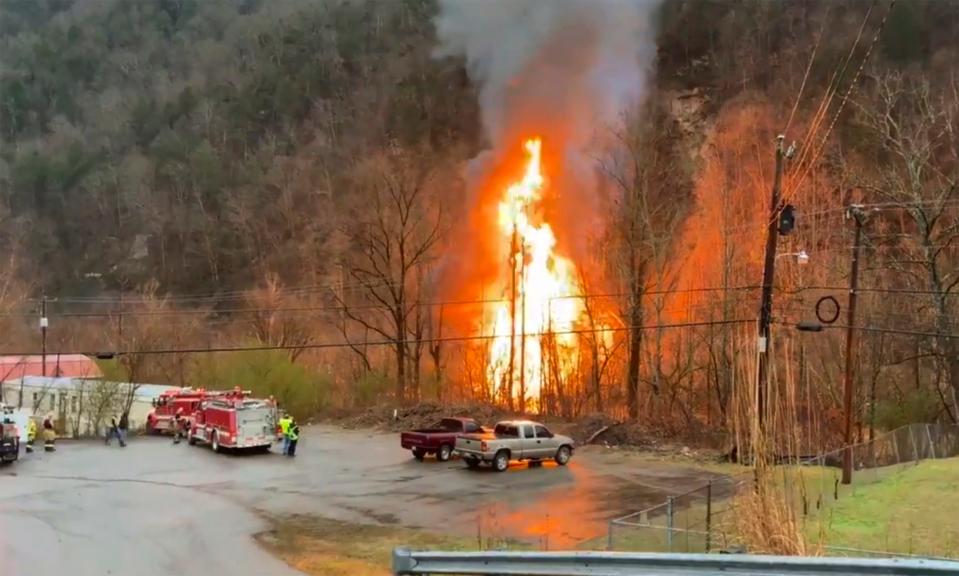
“If the car is on its side, you can't see what the placard is — you don't know,” Reardon said. “If the car is on fire or exposed to flame in some way, shape or form, these signs, they can melt, they can burn off. So, when that happens, you don't know what's in that car, which is why it's important that responders have quick access to the shipping papers for that train. … Once we get those shipping papers in hand, we can tell and confirm what is in that tank car.”
Making a fast and correct response in the face of so many obstacles is where training — and, better yet, experience — is so important.
All firefighters receive some training on hazmat incidents, including how to identify different materials and the best way to respond. Departments in larger cities like Cincinnati, Detroit, Indianapolis, Louisville and Peoria have designated hazmat teams. To serve on those teams, firefighters must earn an additional training certification. In Illinois, for instance, Sollberger said that requires an 80-hour course and then shorter trainings annually to stay certified.
Some local teams also conduct training in conjunction with carriers. In Louisville’s Pleasure Ridge Park fire district — which includes the Rubbertown industrial area — the railroads have brought in a "prop" car to help responders practice working with a tanker derailment.
That cooperation builds relationships and fosters communication essential to a successful response. Pleasure Ridge Park Fire Chief Jason Meiman said they’ve never had a problem getting a list of chemicals in a timely manner following an accident. That’s important because many chemicals react differently when mixed or require different mitigation tactics. Some, for example, should not be doused with water.
Capt. Ron Troutt, hazmat coordinator for the Indianapolis Fire Department, said his team of about 140 trains monthly. It helps keep members fresh, he said, and lets them practice different skills. A recent session focused on slowing or stopping a propane leak, and an upcoming exercise is on rail cars carrying chlorine.
While that training is essential, Troutt said, actual on-the-ground experience is unparalleled.
"Training means yes, you can play football," he said. "But additional training and especially lots of experience on actual incidents means you play like Peyton Manning."
Safety regulations face strong pushback
Well-trained emergency responders are an important tool, but retirements and declining funding has Troutt and others worried about some communities losing experienced hazmat responders and, in some case, even their specialized teams.
Federal support for hazmat equipment and training shot up after the 9-11 terrorist attacks, but much of those resources have now dried up, Troutt said. The Washington Township Avon Fire Department in Avon, Indiana, a suburb west of Indianapolis, is among those that shut down dedicated hazmat teams despite having a major railyard in its jurisdiction. These changes mean the region and country as a whole have less capacity to respond to hazmat incidents, Troutt said.
Butters, the transportation safety expert and former deputy administrator at PHMSA, said pro-active prevention is the best approach in the long run. “What we need to do,” he said, “is focus on the causes and what we are going to do to try to prevent them from happening in the first place.”
“The more frequent and higher volume of hazmats being moved, the possibility of an accident goes up,” he said. Incidents like East Palestine “put laser focus on hazmat transportation, but will that still be there in a year? Complacency can come in,” Butters added.
Shortly after the East Palestine incident, Sarah Feinberg, who headed the Federal Railroad Administration under President Obama, said the derailment points to a systemic breakdown and the challenges of improving safety. The transportation and chemicals industries tout their commitment to safety, but they also have a history of pushing back against new regulations.
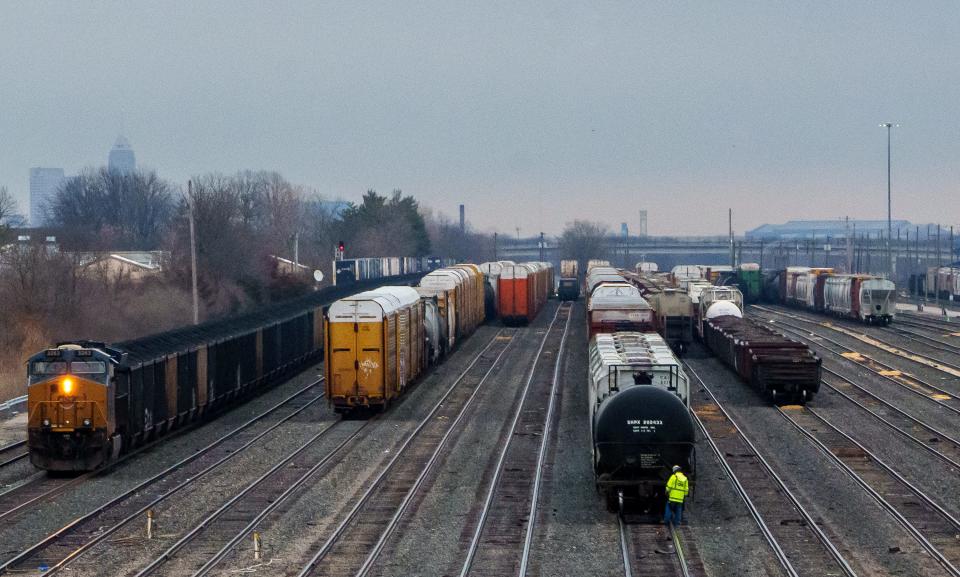
Norfolk Southern said in a statement it is committed to being the "gold standard" for safety and supports efforts to improve safety, such as strong "tank car standards and first responder preparation — which benefits any type of incident."
But the company, along with CSX and other rail freight operators, spent more than $400 million in the past two decades lobbying the federal government on key issues, including pushes to ease, rather than strengthen, safety standards. In recent years, railroads also have adopted a new strategy called PSR, designed to boost profits with longer trains and fewer people — both of which can lead to more accidents, according to experts.
Mikal Watts is among the attorneys overseeing more than 30 lawsuits filed against Norfolk Southern after the East Palestine accident. He said the U.S. Environmental Protection Agency “seems to be a yo-yo,” and regulations that keep Americans safe are seemingly “cast aside” by changing administrations.
With rail, for example, a regulation established in 2015 under the Obama administration required the installation of electronically controlled brakes — which apply braking simultaneously to all cars to slow trains faster and more smoothly — on certain trains carrying hazardous materials. But the Trump administration rolled back the rule, contending the costs exceeded the benefits.
Around that same time, Norfolk Southern wrote in public comments submitted to the U.S. Department of Transportation that it appreciated the opportunity to participate in a “wide-sweeping, and necessary, review of the regulatory burdens” imposed on the industry.
Watts said he hopes the legal action against Norfolk Southern will not only compensate victims in Ohio, but lead to better regulation of hazmat transportation.
The EPA often regulates the chemical itself. PHMSA ensures that the package or container carrying the hazmat can withstand a certain level of accident. And agencies like the ones that oversee rail and highway are responsible for ensuring the infrastructure is maintained.
As victims and safety advocates push for more transparency and regulation of chemicals moving through communities, a few are calling for more dramatic change: Finding ways to reduce the heavy reliance on hazardous materials.

"We have to ask, ‘how much is the human life worth? And do we even need some of these dangerous chemicals going through our communities anyway?’” said Monica Unseld, who holds advanced degrees in biology and public health and now leads Until Justice Data Partners in Louisville.
“This isn’t NIMBY,” she said. “This is, ‘I don’t want a bomb train behind my house, or going past my child’s school.’”
Reporters Sarah Bowman, Connor Giffin, Keith Matheny, Patricia Newberry, Katherine Oung, Karl Schneider and Jennifer Shaffer contributed to this story.
This article originally appeared on Akron Beacon Journal: East Palestine train derailment shines light on hazardous materials

